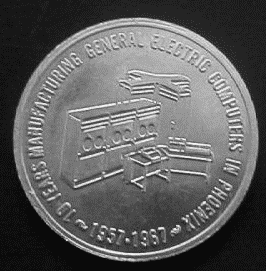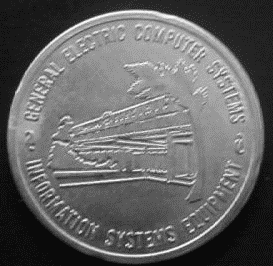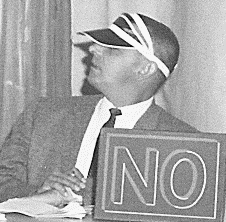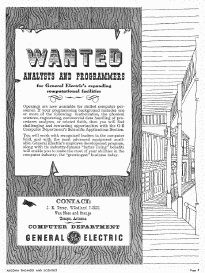|
"YOU/and
the Computer"
1965 STUDENT GUIDE
produced by
GENERAL ELECTRIC
Printed
in 1965 and used to introduce students (usually employees) to the rapidly
growing world of computers. It uses anecdotes, cartoons, and
pictures in presentation of existing and future computer applications.
Included are the computer's capacity,
how it works the same as humans, programming, the binary code, symbolic
languages, memory, computer operation and how you talk to a computer.
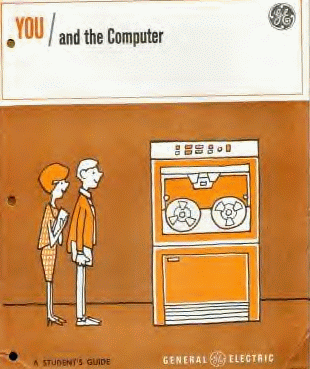 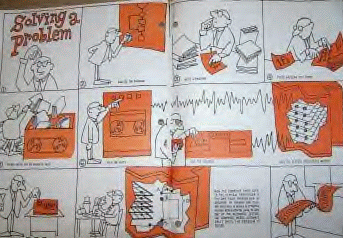
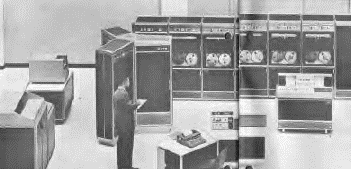 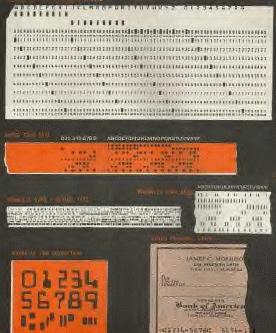
GE COMPUTER DEPARTMENT Event
(Time) Line ( from the retirees)
1948 GE's Electronic's Laboratory, Syracuse, NY, builds OARAC
vacuum tube computer for Wright Patterson Air Force Base.
1952 Homer (Barney) Oldfield1 opens the Advanced Electronics
Center (AEC) in Ithaca, NY, as General Manager; Walker Dix2,
Engineering Manager. PING putter designed by AEC engineer Karsten
Solhein in his garage.
1953 Heavy Military Electronics Department (HMED), Syracuse, NY,
awarded contract for development and production of the Radio
Guidance & Tracking system for the Atlas ICBM, with Dr. Lewis
Neelands as chief architect of the overall system.
The 'information procesing' sub-system was named MISTRAM
(Missile TRAjectory Measurement), with John Couleur as lead
architect.
1954 Barney Oldfield founds the Microwave Laboratory at Stanford
University, Palo Alto, CA.
1955 Spring George Metcalf's Report on the future of the
Electronics Industry. Chapter on 'Electronic Computers',
authored by Clair Lasher, predicted that, believe it or
not, 'Electronic Computers' would become commercially feasible
and the fastest growing segment of the Electronics Industry.
1955 Summer Claire Lasher, assisted by George Snively and others,
under the auspices of the Technical Electronics Equipment
Department prepared a business plan to go into the Computer
Business. Claire asks Oldfield to check into the SRI ERMA project
for him. The plan was returned from Ralph Cordiner with a
big 'No RJC'. scribbled across it with an orange crayon.
1955 Fall Ralph Cordiner follows up his "no" with a
letter stating: "UNDER NO CIRCUMSTANCES WILL THE GENERAL
ELECTRIC COMPANY GO INTO THE BUSINESS MACHINE BUSINESS. HOWEVER,
SOMETIME IN THE FUTURE, IN SUPPORT OF OUR HISTORIC BUSINESS IT MAY
BE NECESSARY FOR US TO GO INTO THE PROCESS COMPUTER BUSINESS".
1955 October Bob (Dr.Robert R.) Johnson transfers from the
Syracuse Electronics Lab to the Microwave Lab as its Engineering
Manager. Bob and his associates play a major role in the ERMA
proposal and in the early design and development of the ERMA
machine. He later transferred to Phoenix as the Computer Department's
Engineering manager.
1955 Fall Dr. Baker approves B of A Letter of Intent for $30
million of ERMA (Electronic Recording Method of Accounting)
systems as a "process computer" and authorizes $50,000
to write a proposal and negotiate contract. (Final contract not
signed until shipment of the last ERMA system, by which time the
contract value had increased to $50 million total.)
1956 February 3 ERMA proposal submitted to B of A, negotiations
begin. Cordiner wanted no part of this business. In fact, it's
believed that the only reason Cordiner let Baker's group make a
bid was because Cordiner was assured by his staff that IBM would
win the contract hands down.
1956 May ? Ken McCombs opens Computer Department payroll account
for himself, Owen Lindley and George Snively. (Barney Oldfield on
Microwave Laboratory and later transferred to the Technical
Electronics Equipment Department's payroll. Not added to CD
payroll until fall 1956.)
1956 June 28 Industrial Computer Section holds Computer Symposium
at Electronics Park in Syracuse. Barney Oldfield shown as General
Manager, Computer Department, reporting to Harold Strickland,
Industrial Electronics Division. Geiser, Lasher, Barclay, McCombs
& Newman shown as sub-section managers. Barney Oldfield
interviews Dr. Herbert R. J. Grosch.
1956 July ? Office opened in Lee Lee Building, above Wittig's Ice
Cream Parlor, on East Gennesse Street in Syracuse. Ray Barclay,
Art Newman & Ken Geiser added to CD payroll.
1956 August ? Site selection team formed.
1956 September NCR Contract signed for development of the ERMA
check reader.
1956 November 2 Herb Grosch calls a press conference in Tempe,
Arizona andprematurely announces that he has selected Phoenix and
the rest will follow. He announces a computer center to be
established at Arizona Normal (later State) University with an
IBM704 computer (which he diverted from the Jet Engine Department
in Evendale, Ohio, and which had a military priority!)
1956 November 5 Site team selects Phoenix as the site. Barney
Oldfield prepares a $5,000 Appropriations Request for a sales
office in Phoenix to liaison with B of A. Will hand carry to Harld
Strickland's office to try to get approval.
1956 November ? GE signs option on 1,000 acres accumulated from
John Jacobs, (?) Eaton and one other, on Black Canyon Hwy at
Thunderbird Road.
1956 November 17 Barney sends Manufacturing people (Stan Brown,
Earl Kittle, Don Reed and wives) on the road to Phoenix with
orders to call in each night to receive instructions as to whether
or not to keep proceeding.
1956 November 20 Strickland signs $5,000 appropriation. Oldfield
calls the Lee Lee building and the engineers in the General
Engineering Lab in Schenectady and tells us to get on the road to
Phoenix. He will be unavailable after he hangs up.
1956 November 26 Manufacturing people procure office space on the
5th floor of the new First National Bank of Arizona at 401 North
Central Avenue, Phoenix, AZ. Sign on door read "GE Computer
Department".
1956 Installation of the first Atlas Radio Guidance system begins
at Cape Canaveral, Florida; Walker Dix, Site Manager.
1957 January ? Additional space acquired on the 2nd floor of the
KTAR building on North Central Avenue.
???? ERMA project moved into facility on Charleston Road in
Moutainview, CA.
1957 Computer Department leases ASU's new Engineering building.
1957 ? Eaton builds 5,000-sq. ft. facility on Peoria Ave. to lease
to Computer Department.
1957 October Product Scope meeting creates charter for
a 'Computer Department'.
1958 Deer Valley plant built.
1959 February First ERMA shipped. Upon delivery, Ronald Regan
hosted the press event.
1959 April Cordiner fires Oldfield following the ERMA dedication
ceremony at the B of A. Claire Lasher appointed Acting General
Manager with orders to complete the ERMA and NCR 304 contracts and
to get out of the 'Business Machine' business and concentrate
on process computers. Next 18 months spent planning the' Big Look' in an attempt to get Cordiner's decision reversed.
1959 Decision to launch the GE-225, a 20-bit computer, designed by
Arnold Spielberg4 and Chuck Prosper, based on the GE-312 and
GE-412 process control computers.
1960 HMED receives Cordiner's okay to market a
militarized/hardened version of the "MISTRAM"
information processor. as the the M-236 ("M" as in
military, "36" as in 36-bit) computer.
1960 Decision to launch the Mosiac line, a family of 24-bit
computers, as the GE-400 series.
1961 Spring Claire Lasher gets OK to implement the 'Big Look'
from Cordiner.
1961 May Second First Annual National Sales meeting at
Superstition Hotel in Apache Junction, AZ, kicks off the 'Big Look'.
(The 'First Annual' meeting was canceled when Claire didn't get an
earlier meeting with Cordiner.)
1962 Start of the design of the GE-235, a faster version of the
GE-225.
1962 CD commences design/development of the 'Y-series'
computer as the high performance upgrade of the GE-400 line.
1962 HMED commences development of the M-2360 as a high
performance upgrade of the M-236.
1962 July First sales pitch by John Couleur for M-2360 versus the
Mosiac"Y. machine.
1963 1Q An evaluation team, led by Dr. Don Shell, manager of the Mathematics
Department, GE Research Lab, reviews the design and
status of the Computer Department's 'Y' machine and HMED's
M-2360. The team recommends the latter as the next large scale
computer to be offered by GE (as the GE-600 Series.)
1963 February Clair Lasher replaced by Harrison Van Aken as
general manager of the Computer Department.
1963 CD's Advanced System Lab and Dartmouth College begin
development of a time-sharing operating system, including the
Basic language, running on GE-235 and Datanet-30 hardware. The
system became operational in 1964, and the software became the
Dartmouth Time Sharing System (DTSS).
1963 Ralph Cordiner retires; Fred Borch selected as his successor.
1964 First shipment of the Datanet-30, a data communications
mini-computer, designed
by Bill Bridges based on the GE-312 process control computer.
1964 First shipment of the 24-bit GE-400 series.
1964 Discussions with MIT's Project MAC group, led by John Couleur,
re modifications/additions to the GE-635 architecture to address
Project MAC's time-share needs; start of development to implement
such changes in a new product designated as the GE-645.
1964 March Lou Rader re-hired from Univac as VP, Industrial
Electronics Division
1964 June Announcement of the GE-600 line, based on the Syracuse
M-2360 hardware, with GECOS (General Electric Comprehensive
Operation System) developed in Phoenix.
1964 November Formal take-over of Bull by GE.
1964 August Contract signed with MIT (for Project MAC) for a
GE-645. The software, a new paged time-sharing system named
MULTICS (MULTiplexed Information and Computing Service), to be
developed jointly by GE's Cambridge Information Systems Laboratory
(CISL, reporting to Phoenix), MIT and Bell Labs.
1965 April First shipment of the GE-635 prototype, with GECOS I
software.
1965 Introduction of the packaged GE-265 system, consisting of the
GE-235 and Datanet-30 hardware (235+30=265) and the DTSS/Basic
software, achieving fame as the first fully integrated commercial
"time-sharing system" and the backbone of GE's
Time-Sharing business.
1965 Licenses negotiated with Toshiba and Nippon Electric Co.
(NEC) for manufacture of the GE-600 line.
1965 November First release of GECOS II.
1966 January H. Van Aken replaced by Lou Wengert as general
manager.
1967 January GE-645 delivered to Project MAC.
1967 GE-645 hardware group transferred to HMED, Syracuse,
reporting to Walker Dix.
1967 First release of GECOS III, with an embedded time-sharing
sub-system (TSS).
1967 Development started for the GE-655, a new design with
integrated circuit modules, liquid cooling, 2x the speed of the
GE-635, and start of construction of a new manufacturing facility
at Deer Valley to produce the new IC modules.
1968 First release of the IDS (Integrated Data Store) data base
software for the GE-600 line, one of the first database management
systems; developed by Charles W. Bachman6.
1968 GE creates a new Computer Division, consisting of the Large
Systems Department (LSD), the Medium Systems Department (MSD, The
Small Systems Department (SSD) and the Special Information Systems
Department (SIPD). The Computer Division grew into the GE
Information Systems Group, with 25,000 employees and $1.5 billion
in installations.
1968 Transfer of the HMED engineering sub-section responsible for
the M-2106 development (largely intact, and tagged with "The
Syracuse Mafia" moniker ), along with the recently
transferred GE-645 group, to Phoenix as the nucleus of LSD's
hardware engineering staff. Walker Dix appointed Engineering
section manager.
1968 December Stanford Smith is replaced by Hillard Page as VP
Information Systems Group; John Hanstra appointed Information
Systems Equipment Division Manager.
1969 Jul-Oct Shangri-La seminar at Hollywood-by-the-Sea, Florida,
to formulate a plan for a new GE Advanced Product Line
1969 August John Hanstra dies in his private aircraft crash; John
Burlingame named in replacement.
1970 Oct GE's computer systems business, less the time-sharing
business, is sold to Honeywell, Inc, and becomes part of Honeywell
Information Systems (HIS), consisting of the facilities and
personnel at Phoenix and Oklahoma City (GE) and at Bellerica and
Foxboro (Honeywell), and presided over by Clarence (Clancy)
Spangle as one of two major groups of Honeywell, Inc. Norman
Feldman named VP of the Phoenix Computer Operations (PCO),
reporting to Lee Sheenam, VP of the Computer Systems Division (CSD);
Walker Dix named as PCO Director-Engineering.
1973 May Honeywell announces reorganization of CSD reorganization,
with four operations reporting to Lee Sheehan: The Computer
Systems Division Operations, headed by VP Norm Feldman, responsible
for assisting Lee Sheenan at the divisional level in the general
management of CSD; the Phoenix Computer Operations, headed by VP
Norm Feldman (Acting), responsible for the Manufacturing, Quality
Control, Finance and Employee Relations functions at Phoenix,
Oklahoma City and San Diego; the Boston Computer Operations,
headed by VP Lee Sheehan (acting), responsible for the same
functions at Billerica and Foxboro; and the Engineering
Operations, headed by VP Walker Dix, responsible for all
Engineering functions across CSD.
1973 First shipment of the GE-655 as the Honeywell 6080.
1988 Honeywell Information Systems, Group Bull and NEC form a new
entity named Honeywell Bull.
1991 Honeywell Information Systems sold to Groupe Bull. The new
entity is named 'Bull HN'.
Compiled by Walker Dix, 23 April 2009
Revised 23 May 2009
Footnotes:
1 Computer Pioneer Award, 1997, for "Pioneering work in the
development of banking applications through the implementation of
ERMA, and the introduction of computer manufacturing to GE".
2 GE Cordiner Award, 1963, for "Contributions as Program
Manager for the Atlas/MISTRAM program in acquiring and executing
the US Air Force MISTRAM contract, valued at $200+ million".
3 GE Cordiner Award, 1963, for "Contributions as the leading
architect in the conception and implementation of the MISTRAM
information processing system".
4 Computer Pioneer Award, 2006, for "Contributions to real
time data acquisition and recording".
5 Computer Pioneer Award, 2001, for "The marrying of
computers and communications technology in the Datanet-30".
6 ACM Turing Award, 1973, for "his outstanding contributions
to database technology"; elected as a Distinguished Fellow of
the British Computer Society, 1977, for his pioneering work in
database systems"; listed in the Database Hall of Fame.
|
|
